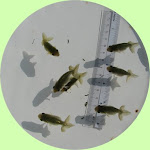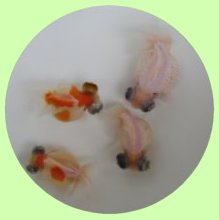The Allure of the Japanese Ranchu ~ 魅力蘭壽
有些時候,換個視角就看得到光明了。
~ 丹·布朗
Sometimes, a change in perspective is what it takes to see the light.
~ Dan Brown
Most who had visited Japan would be awed by its unique culture that has been very successful in conjugating tradition with modernization. Albeit Japan's technological prowess, various ancient trades and art still persist in the traditional way, reverberating the candid contrasts of old and new in the Japanese's lifestyle and society.
Goldfish aquaculture in Japan is no exception. Long before the advent of glass tanks, goldfish were kept in ponds and naturally, they were bred to be appreciated from the top view. Today, many Japanese goldfish varieties are still bred for their top view aesthetics with some of the important goldfish competitions in Japan still assessing the goldfish from the top view.
Ranchu Competition in the AJRS (All-Japan Ranchu Show)
The most famous of all Japanese goldfish is of course the Ranchu. In fact, the Chinese Ranchu was created in the early 80's when the Japanese Ranchu was introduced into Fuzhou to cross with the Chinese lionhead. Ironically, it was the Chinese Ranchu that first took the goldfish world by storm. The Thai breeders have also imported the Japanese ranchu and selectively bred it for appreciation in the side view profile. The Thais, being very skilled in ornamental fishes, and inevitably these ranchu become very popular too and are widely known as the Thai ranchus (side view appreciation).
 |
| Top view profile of a Chinese ranchu: head is more rounded, body more olive shaped, peduncle thinner and tail are not so widely open |
 |
| Top view profile of a Japanese ranchu: head is squarish, thick back, streamline body and wider tail spread |
Why are the original Japanese ranchu not as well known as their cousins in China and Thailand? The main reasons being that in Japan, ranchus were mostly bred by closed groups of Japanese hobbyists in ranchu clubs, hence the lack of commercialisation until the age of the Internet in the mid 90s. Another reason is that most hobbyists are not accustomed to appreciating goldfish from the top view because of the popularity of keeping goldfish in glass tanks.
What then is the allure of the Japanese Ranchu? For a culture passionate about the refinement of anything, the aesthetics of dynamics is but only a natural course in the Japanese goldfish art and culture. The Japanese ranchus are bred not only to look beautiful from the top view but also to swim beautifully. They also seem to exhibit very different temperament from the Chinese and Thai ranchus; Japanese ranchus are extremely hyperactive like playful puppies. This could be due to their structure that was bred for swimming aesthetics.
The most endearing moment for the Japanese Ranchu keeper is a shoal of cute ranchus wagging their tails and sexy peduncles in anticipation of their meals. Their active temperament, stocky peduncle, broad back and wider tail spread are a real joy to be appreciated from the top view ponds. Many people who started keeping the Japanese ranchu soon realised that they have open up a whole new perspective in enjoying the goldfish hobby.
The most endearing moment for the Japanese Ranchu keeper is a shoal of cute ranchus wagging their tails and sexy peduncles in anticipation of their meals. Their active temperament, stocky peduncle, broad back and wider tail spread are a real joy to be appreciated from the top view ponds. Many people who started keeping the Japanese ranchu soon realised that they have open up a whole new perspective in enjoying the goldfish hobby.
Always therapeutic to watch a group of healthy ranchus feeding
Tips of starting the Japanese Ranchu hobby:
The Japanese ranchu have been closely inbred and isolated for more than a century in Japan and are very sensitive to gill bacterial and gill flukes. A wrong footing in the hobby can prove very painful and disastrous for the newbie. However, the Japanese ranchu can be very easy to keep if we are discipline and observe some basic rules.
1) Reliable source
Get your Japanese ranchu from a source who has quarantined and acclimatized the ranchus to local conditions for sometime. Healthy fishes should be eating well and swimming actively.
2) Do not mix Japanese ranchu with other types of goldfish or ornamental fishes.
Avoid mixing Japanese ranchu with other types of goldfish or ornamental fishes from other continents. The Japanese ranchus are not well immune to new pathogens carried by fishes from other continents due to a century of isolation. Mixing them is not impossible but usually prove very tricky. The story of all Japanese ranchu wiped out in a matter of days after mixing with other varieties of goldfish is all too common.
3) Learn to diagnose their sickness before they deteriorated.
With early diagnosis and applying the correct treatment, the chances of recovery is very high. For such hyperactive fishes, low appetite, listlessness, parking on the bottom or floating near the water surface are tell-tale signs of sickness. The good news is, the majority of the sickness can be tackled with salt and anti-bacteria treatment in the early stages of development.
4) Be familiar with the basics and salt treatment techniques
Perform the salt treatment whenever you mix fishes from different sources or different ponds. Salt treatment should be used as a routine maintenance too. The salt treatment article which I shared in an earlier post has received very favourable feedback from hobbyists who tried it out. They observed that the fishes have improved in health and growth.
Close up.. focus on the tail and the thick peduncle
5) Water quality and feeding
A good water change regime based on your stocking and feeding should be observed by the ranchu keeper. In essence, learn to feel and read the water quality by studying the behaviour of your ranchus. Water change regime will vary according to the stocking, feeding and environmental factors.
In general, for goldfish keeping in Singapore, water change should be at least 80% to 90% once every 7 days. The frequency of water change also depends on your stocking, feeding and weather conditions. it is highly recommended to buffer the water with baking soda because we have very soft municipal water. The guideline is one tablespoon of baking soda for every 25 US gallon, which should buffer the water to maintain a stable pH above 7 for a week or so under normal conditions.
Either a bio-filter system indoors or the natural wall algae and green water in the outdoor can be used to maintain the water quality. The later is preferred as goldfish are essentially outdoor fish that do best with ample sunlight. Some advance hobbyists have also successfully used the high output T5 lightings or the metal halid to groom wall algae and natural green water algae to maintain good water quality indoors.
6) Well balanced diet
In competitions, winning ranchus are ranked in accordance to the sumo titles. Sumo wrestlers may be big and fat but they are not the average fat man; they are very strong and very agile - thanks to the nutritional food and a strict exercise regime. It is the aspiration of the Japanese breeders to develop their ranchus like sumo wrestlers. So it is the same for the ranchu - big, strong structure nurtured with good exercise and a well balanced diet.
More frequency of lighter meals is preferred to a few heavy meals. Keep them well fed, but not too indulged so that they will have plenty of exercise foraging the pond for food. The older second year (nisai) and third year fishes (oya) also do not need as aggressive feeding as do young yearlings (Tosai).
7) Start small
 |
| Black Baby Ranchu (BBR) |
Eventually, most hobbyists do not need to acquire very expensive or very high grade ranchu to enjoy the hobby. Most are just happy with the average ranchu for general appreciation. Like many other hobbies, it all depends on how we want to play, there are different grades of ranchu to satisfy players of all levels and expectations.
You may contact me for any queries regarding the Japanese ranchu or any type of goldfish. No purchases is required.
Recommended readings:




















